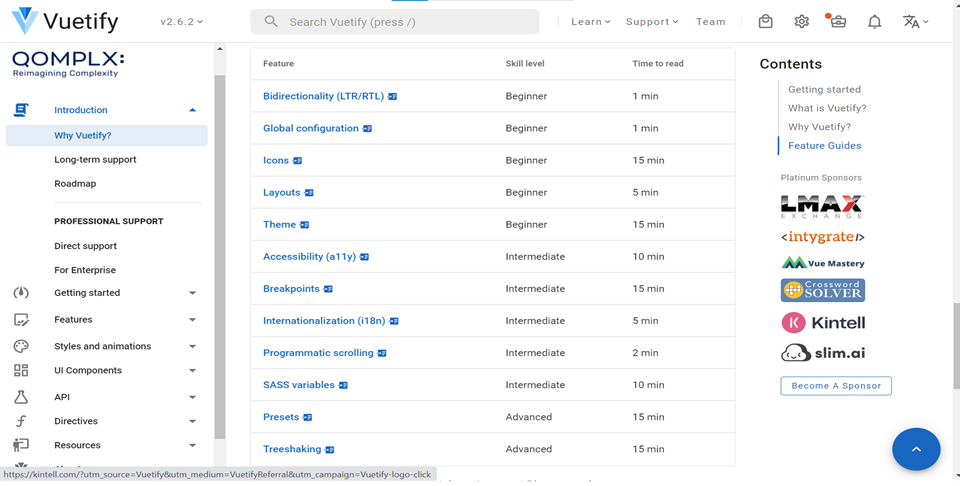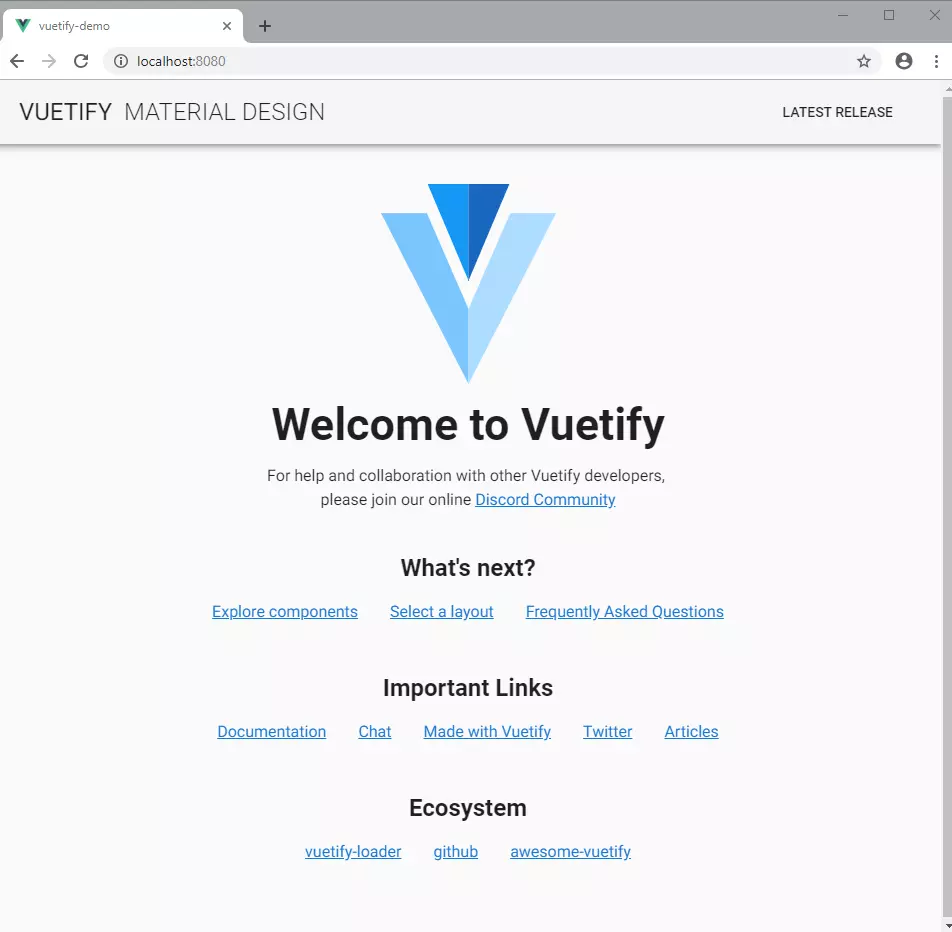Building Frontend Using Vuetify
Building an intuitive user interface for an application is a talent that takes knowledge and experience to master.
Although Vuetify won't transform you into a knowledgeable UX practitioner over night, it will give individuals who are just getting started in this field a strong foundation.Vue.js has advanced to become one of the most widely used JavaScript frameworks worldwide since its original release in 2014. The widespread use of components, which enables programmers to construct succinct modules to be utilised and reused across their application, is one of the factors contributing to its popularity. These modules are grouped together to form UI Libraries, which give developers the resources they need to create complex web applications while implementing a certain design standard.
What is Vuetify?
Vuetify is a complete UI framework built on top of Vue.js. The goal of the project is to provide developers with the tools they need to build rich and engaging user experiences.
An open-source MIT project called Vuetify is used to create user interfaces for web and mobile applications.
Sponsors and volunteers from the Vue community have backed the initiative. A thriving Discard community forum for the project allows you to ask questions regarding JavaScript, even if they have nothing to do with Vuetify. Through regular update cycles, the development team is devoted to addressing bugs and delivering improvements.
Weekly fixes are also released to address problems reported by the community.
Because Vuetify uses a mobile-first approach to design, your application will function on any device right out of the box, including phones, tablets, and desktop computers. This amount of care is not typically given to open-source frontend libraries. Therefore, you can be sure that once you begin utilising Vuetify in your projects, you won't be abandoned without support. All popular browsers are supported out of the box with Vuetify. Older browsers like Safari 9 and IE11 can still function but will need babel-polyfill. Anything older than that is not supported. Vuetify is built to be semantic. As a result, it will be simple for you to remember and use every component and property name you learn without constantly consulting the documentation.
Vuetify Documentation:
If you are an experienced developer and want to compare Vuetify to other libraries/frameworks, you could see the popularity of vuetify through a Vue Frameworks Comparison 2021 chart provided by vuetify documentation. Vuetify documentation also helps us to clearly understand the various features that are offers by Vuetify like styles and animations, UI components, API, directives. These outstanding features help us to save lots of our time from writing a huge CSS styling. A detailed feature guides provide by vuetify documentation helps us to learn more about the inner workings of Vuetify and how to become a skilled v-developer. Each guide is designed to teach you how to get the most out of your development experience with information on how to build responsive pages using Layouts, how to customize the style of your application with SASS variables, and how to slim down your application’s package size via Tree shaking, and more.

Prerequisites:
Developers with intermediate or expert Vue.js knowledge should read this guide.
If you have never built applications using Vue.js
Installing Vuetify:
You can easily install Vuetify as follows if you already have an existing Vue project that was made using an earlier version of the Vue CLI tool or another method:
Update your index.js or main.js and include the following code:
Import Vuetify from “vuetify”;
Import “vuetify/dist/vuetify.min.css”;
Vue.use (Vuetify);
You’ll also need to install Material Icons, which you can include as a link tag in your index.html file:
<link herf=” https://fonts.googleapis.com/css?family=Roboto:100,300,400,500,700,900|Material+Icons%27%20rel=%22stylesheet”>
</head>
If you are starting a new project, installing Vuetify is very easy. Just follow these steps:
$ cd vuetify-demo
$ vue add vuetify
$ ? Choose a preset: (Use arrow keys)
$ > Default (recommended)
$ Prototype (rapid development)
$ Configure (advanced)
When prompted to select a preset, simply select Default, which stands for the a la carte method. In essence, this implies that just the Vuetify components that are actually being used in your application—and not the full Vuetify library—will be packed together for deployment. This will significantly reduce the size of your frame. Vue UI can be used to include Vuetify into your project. Let's use Vuetify now that it has been installed.
The Basics:
You'll notice quite a few changes to our project's structure and code as soon as Vuetify is included.
App.vue is important to us right now.
<v-app>
<v-toolbar app dark class="indigo">
<v-toolbar-title class="headline text-uppercase">
<span>Vuetify </span>
<span class="font-weight-light">MATERIAL DESIGN</span>
</v-toolbar-title>
<v-spacer></v-spacer>
<v-btn flat href=https://github.com/vuetifyjs/vuetify/releases/latest target="_blank">
<span class="mr-2">Latest Release</span>
</v-btn>
</v-toolbar>
<v-content>
<HelloWorld />
</v-content>
</v-app>
</template>
If you start the server and open localhost:8080, you should have the following view:

#Theme configuration
Vuetify offers easily change the colours of your application programmatically. Rebuild the framework's default CSS and adjust different elements to suit your requirements. Discover and generate new colour themes for your Vuetify applications using Theme Generator tool provided by vuetify.
Light and dark
Both the light and dark variations of the Material Design spec are supported by Vuetify.
This designation is supported by the majority of components and begins with the v-app, the root application component.
Your application will use a bright theme by default, but you can quickly change this by adding a dark option to the theme service.
// src/plugins/vuetify.js
import Vuetify from 'vuetify/lib'
Vue.use (Vuetify)
export default new Vuetify ({
theme: {dark: true},
})
When you designate a component as light or dark, all its children will inherit and apply the same unless otherwise specified. You can manually turn dark on and off by changing this. $vuetify.theme.dark to true or false.
Vuetify vs Vue CLI: What are the differences?
Developers describe Vuetify as "Material Component Framework for VueJS 2".
Vuetify is a component framework for Vue.js 2.It seeks to give straightforward building blocks for creating applications that are clean, semantic, and reusable. With inspiration from other well-known frameworks like Materialize.css, Material Design Lite, Semantic UI, and Bootstrap 4, Vuetify uses Google's Material Design pattern. The "Standard Tooling for Vue.js Development" description is given for the Vue CLI, though. The Vue ecosystem's baseline tooling is intended to be the Vue CLI. It makes sure the many builds tools function well together and have appropriate defaults so you can concentrate on writing your app rather than spending hours fiddling with configuration. Both Vuetify and Vue CLI are largely categorised as "JavaScript Utilities & Libraries" and "Front-End Frameworks" tools, respectively.
